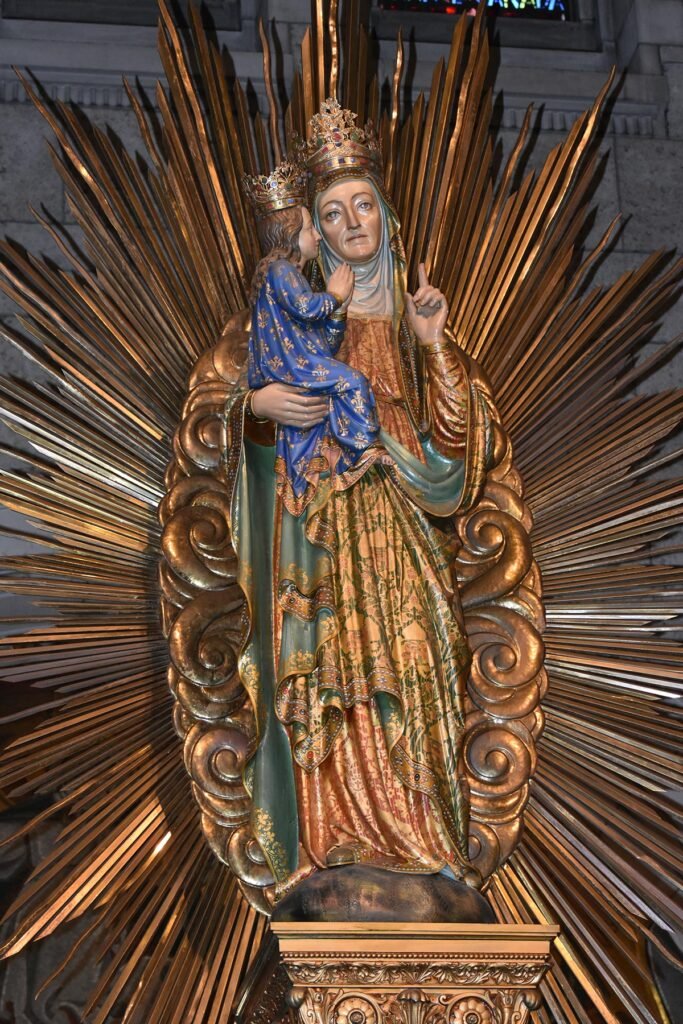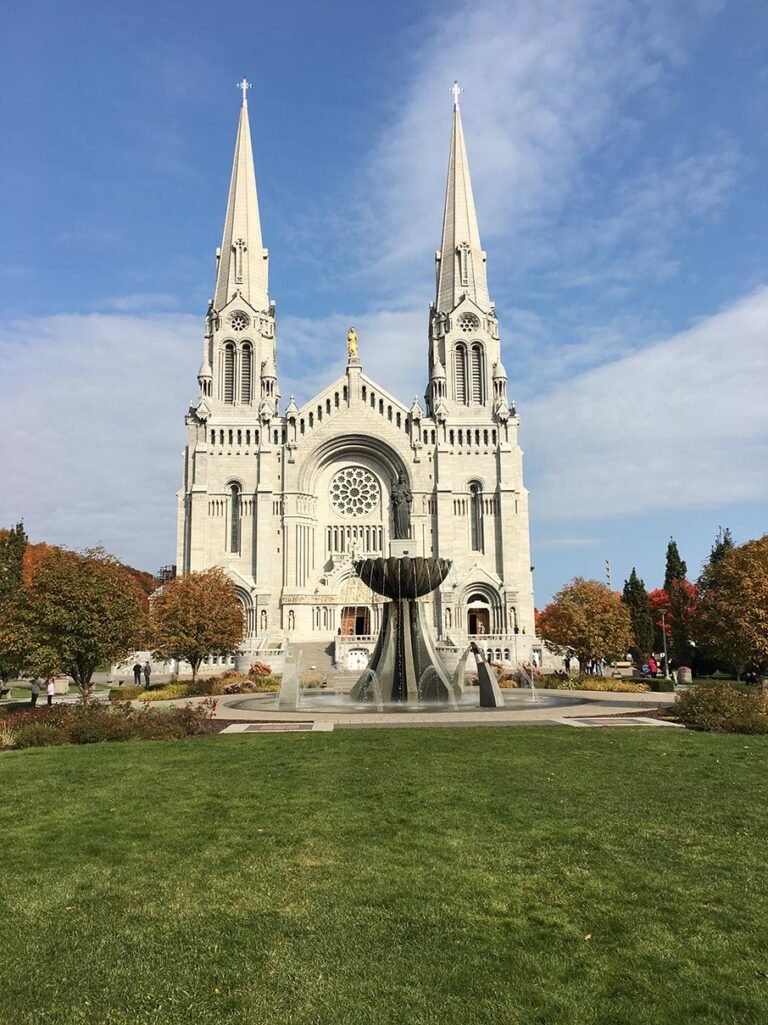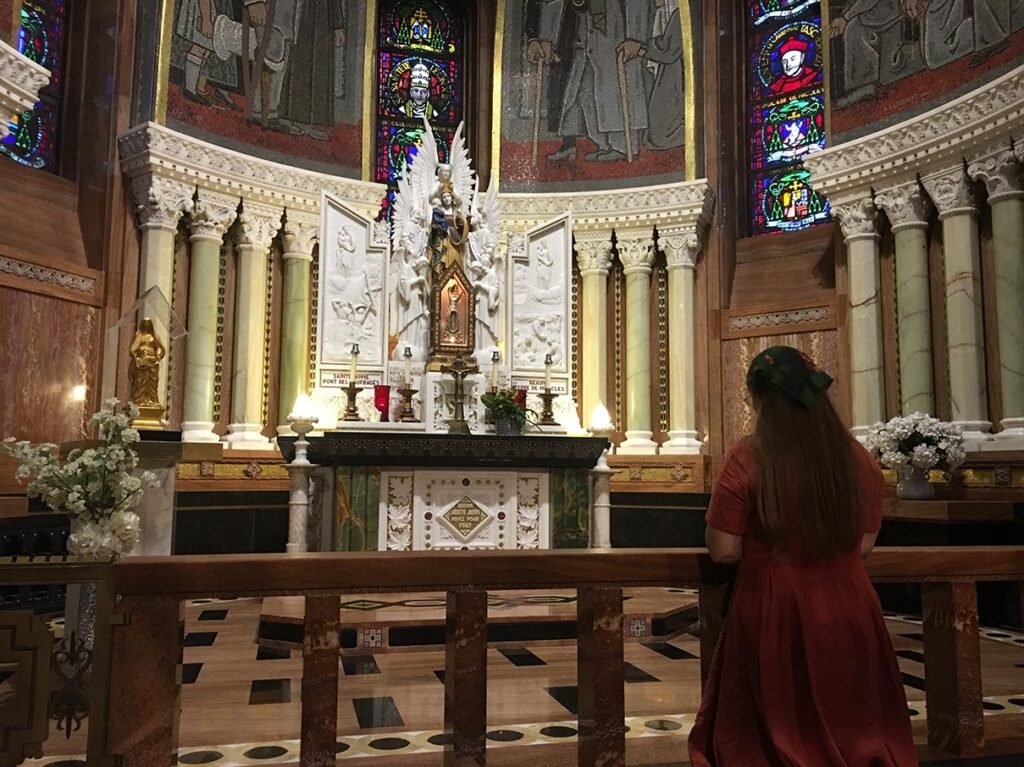Dear readers, I have just returned from a month-long sojourn in the province of Quebec, Canada, to visit family. I have so many things to tell you about people and places, but today I want to spend a little bit of time telling you about our wonderful visit to a shrine dedicated to this channel’s patron, the glorious grandmother of our Savior, St. Anne.

We arrived at St.-Anne-de-Beaupre Basilica and Shrine on a gorgeous October Saturday morning. (Beaupre is two French words joined together to mean beautiful prairie or meadow.) Located about 20 miles north of Quebec City, the basilica’s length parallels the St. Lawrence River.
My first glimpse of the imposing structure was from our hotel parking lot, and she seemed to beckon to us, queenlike, to leave the tawdry commercial establishments along the highway and be received into her royal presence. I could not help but think as I admired her standing firm among the businesses that this view captured the disharmony of our time between the ancient Faith and modernity, between the Social Reign of Christ the King and Americanization.
But I forgot all that upon arrival, eager to pay St. Anne tribute and ask her favors–and to somehow connect across the centuries to the French people who had established an integral Catholic life here. What could we learn from them?
We entered the Shrine grounds from the St. Lawrence River side and our eyes hungrily devoured the many lovely details of the majestic architecture. Then we were drawn to the magnificent fountain in front and listened raptly to the shower of water falling to the pool below as we gazed upward at St. Anne, the child Mary, and then across to the joyful front facade of the basilica, topped with a golden statue. All aglow, it perches on the roof of the basilica between the two towers.

The current basilica was built in 1928 to replace the one that burned in 1922, which tragically was only 50 years old at the time. But even that one wasn’t the first church dedicated to St. Anne at the site. The history goes back several hundred more years.
The Jesuits and French colonists brought devotion to St. Anne with them to New France, and so the very first church dedicated to St. Anne in the area was completed in the 1600s. Despite floods and fires, the devout parishioners always rebuilt.
This testimony is reflected in the Memorial Chapel on an adjoining side street to the Basilica. It was built in 1878 with salvaged materials from the 1676 church. It is set on a treed hillside with a stunning outdoor Stations of the Cross that criss-crosses the terrain, slowly climbing to the Crucifixion scene, which captures the focus at the top center.
Another chapel, The Scala Santa (Holy Stairs), is set to the right of the Memorial Chapel. I’ve seen old photos of people climbing the stairs inside this chapel on their knees, but sadly, both of these Shrine buildings were closed to the public at the time of our visit. I am not sure why. We still enjoyed strolling around the outside, admiring the peaceful setting and seeing the Basilica framed in brilliant green, red, gold, and orange foliage.
Inside the church, two columns decked with crutches grabbed my immediate attention, a testament to St. Anne’s handiwork. Miracles attributed to St. Anne abound, and they started from the moment the first church was being built: One of the workers, Louis Guimond, was healed from rheumatism immediately upon laying three stones for the foundation. The miracles of healing and conversion multiplied, and so pilgrims began flocking to the site, eventually train, boat and ferry service were needed to handle the influx of visitors. I was surprised to learn that Huron Indians made the first official pilgrimage in 1671.
After marveling at the numbers of abandoned crutches, my eyes rose to the towering ceiling and were rewarded with mosaic upon mosaic of intricate beauty, celebrating St. Anne’s life.
Of course every place I looked I could have happily stayed and steeped myself in holy visions. But I hurried to visit St. Anne’s chapel first. Here you will find relics of St. Anne’s forearm and finger. The bone fragment of St. Anne’s finger was brought to the Shrine in 1670 by Bishop de Laval. In 1892, Pope Leo XIII gave a portion of wrist bone from St. Anne’s forearm. Pope John XXIII gave another relic of the forearm in 1960. Both of the forearm relics came from the Basilica of St. Paul Outside the Walls in Rome.

It was somewhat overwhelming to kneel there and pray, knowing that those relics had held Maria Bambina. I confess I had a hard time focusing. When I rose, I spent some time praying at the statues on either side of St. Anne’s chapel, the one for St. John Marie Vianney and the other for the North American Martyrs. I recalled the scenes of torture that Fr. Zepeda had described so vividly in his sermon on the North American martyrs the Sunday before. I wondered what kind of mothering prepares a child to embrace a life like that led by those missionaries–surely not one that emphasizes safety! As mask-wearing in the basilica was strictly enforced, I again felt the strong disharmony between the ancient Faith and modernity.
We longed to tour the many chapels that line the vast area behind the main altar. However, that area was closed, so we spent our remaining time with the famous statue of St. Anne that stands high on a pillar in the north transept of the basilica. Many, many miracles have been won for clients of St. Anne who knelt and prayed at this glorious tribute to her.

At this point a tour guide advised us that a novus ordo mass was about to start, so we slipped away to the downstairs chapel where we studied the many murals, most highlighting the enormous contributions that nuns made to life in New France. Unbeknownst to me, one of the nuns that I came to know and love in the days ahead, an Ursuline in Quebec City, wrote to her son in 1665 about the super abundance of miracles with which St. Anne was blessing her grandchildren:
Seven leagues from here, there is a village called ‘The Little Cape’, where there is a church dedicated to Saint Anne in which Our Lord is working great marvels in favour of the holy mother of the Most Blessed Virgin Mary. There, the paralytics walk, the blind can see, and the sick are healed of every kind of illness.
Marie of the Incarnation













One Response
Wow, so beautiful! The Stations of the Cross are amazing. I have never seen statues that look so real ! And the miracles that have taken place there also are amazing! Thank you for sharing this with us !